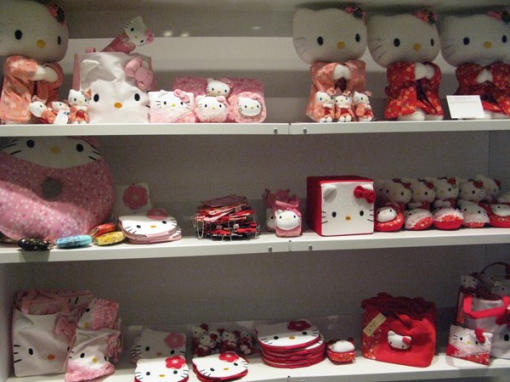Hello Kitty Merchandise
For a lesson plan on Hello Kitty and Japan's soft power, please see William Tsutsui's lesson Popular Culture and Japan's Gross National Cool. Listen to Dr. Anne Allison discuss modern Japanese pop culture icons in Millennial Monsters: Japanese Toys and the Global Imagination Podcast.
Introduced by the Sanrio Company in 1974, Hello Kitty has become a global phenomenon, ubiquitous throughout the world on notebooks, stationary, pencils, clothing, stickers and more. Visa offers a Hello Kitty credit card, and Thai police considered using pink Hello Kitty armbands as punishment. Interestingly, Sanrio gave Hello Kitty a country-specific back story. The official story goes that Kitty White lives with her parents and twin sister in London, England and enjoys traveling, reading, music, eating cookies and making friends. The influences on her design, however, are more cross-cultural, ranging from Snoopy to the Japanese maneki-nekko (lucky cat). Hello Kitty can be used to spark discussion on cultural identification (is she Japanese? British? a citizen of the world) and on Japan's global influence in the popular culture sphere.
For more on Hello Kitty and Thai Police: To Punish Thai Police, a Hello Kitty Armband (New York Times, 8/7/2007). For Hello Kitty's official website: http://www.sanrio.com/
Introduced by the Sanrio Company in 1974, Hello Kitty has become a global phenomenon, ubiquitous throughout the world on notebooks, stationary, pencils, clothing, stickers and more. Visa offers a Hello Kitty credit card, and Thai police considered using pink Hello Kitty armbands as punishment. Interestingly, Sanrio gave Hello Kitty a country-specific back story. The official story goes that Kitty White lives with her parents and twin sister in London, England and enjoys traveling, reading, music, eating cookies and making friends. The influences on her design, however, are more cross-cultural, ranging from Snoopy to the Japanese maneki-nekko (lucky cat). Hello Kitty can be used to spark discussion on cultural identification (is she Japanese? British? a citizen of the world) and on Japan's global influence in the popular culture sphere.
For more on Hello Kitty and Thai Police: To Punish Thai Police, a Hello Kitty Armband (New York Times, 8/7/2007). For Hello Kitty's official website: http://www.sanrio.com/


